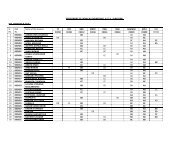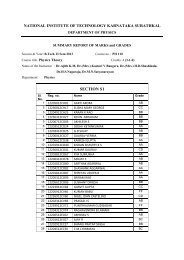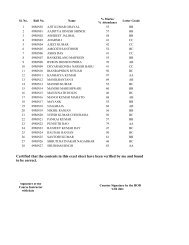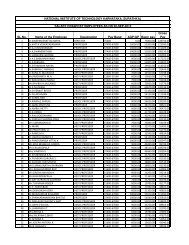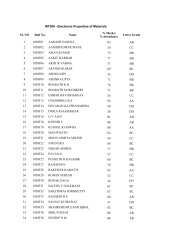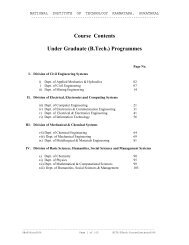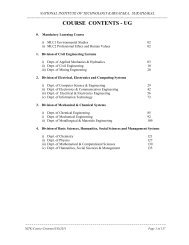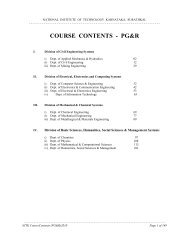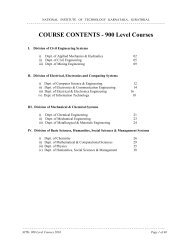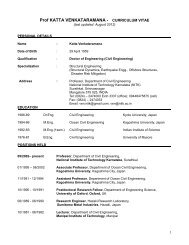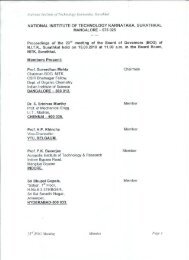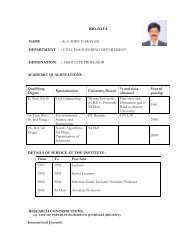course contents - ug - National Institute of Technology Karnataka
course contents - ug - National Institute of Technology Karnataka
course contents - ug - National Institute of Technology Karnataka
Create successful ePaper yourself
Turn your PDF publications into a flip-book with our unique Google optimized e-Paper software.
NATIONAL INSTITUTE OF TECHNOLOGY KARNATAKA, SURATHAKAL<br />
------------------------------------------------------------------------------------------------------------------<br />
Department <strong>of</strong> Chemistry<br />
CY100 CHEMISTRY (3-1-0) 4<br />
Electrochemical Cells - Nernst Equation, Energetics <strong>of</strong> cell reaction, Types <strong>of</strong> electrodes and their<br />
applications, Concentration cells, Primary and Secondary cells, Fuel cells. Electroplating � Theory,<br />
Polarization, Decomposition potential, Overvoltage, Electroplating and Electroless plating <strong>of</strong> copper �<br />
PCB preparation. Corrosion � Types, Theory and factors affecting corrosion, Corrosion control, Galvanic<br />
series, Measurements <strong>of</strong> corrosion rate. Water <strong>Technology</strong> � Hardness <strong>of</strong> water, Boiler troubles, Internal<br />
and external treatments, Desalination. Energy: Fuels, Classification, Calorific value and its Determination, Coal<br />
and its analysis, Petroleum, Catalytic cracking, Diesel and petrol knocking, Reforming <strong>of</strong> gasoline, Synthetic petrol,<br />
Power alcohol, Biodiesel, hydrogen as a source <strong>of</strong> energy. High Polymers: Addition, Condensation and<br />
Coordination polymerization, Copolymerisation, Molecular weights and their determinations, Methods <strong>of</strong><br />
Polymerization, Tg & Tm and factors affecting them, Teflon, PMMA and UF: Elastomers � Compounding, SBR<br />
and silicone rubbers, Conducting, Biodegradable, Liquid crystal polymers. Instrumental methods <strong>of</strong> analysis:<br />
Colorimetry and spectrophotometry, Qualitative and quantitative analysis; Conductometry and Potentiometry.<br />
Semiconductor chemistry: Preparation <strong>of</strong> pure semiconductors, doping techniques. Chemistry <strong>of</strong> Nano � materials -<br />
Nanocarbons, ZnO and TiO2.<br />
Puri B.R. Sharma L.R. and Madan S Pathania, Principles <strong>of</strong> Physical Chemistry, Vishal Publishing Co.,<br />
41 st Edition 2004<br />
Jain P.C. & Monika Jain, Engineering Chemistry, Dhanpat Rai & Sons, Delhi, Revised 14 th Edition 2004.<br />
Kuriacose, J.C and Rajaram, J, Engineering Chemistry, Volume I/II, Tata McGraw – Hill Publishing Co.<br />
Ltd. New Delhi, 2000<br />
Gowariker et al., Polymer Science and <strong>Technology</strong>, Prentice Hall <strong>of</strong> India Pvt. Ltd., New Delhi, 2004.<br />
Chatwal. G. and Anand, S., Instrumental Methods <strong>of</strong> Chemical Analysis, S. D. Himalaya Publishing<br />
House, 2003.<br />
Mars G. Fontana, Corrosion Engineering, McGraw Hill Book Company, 1986.<br />
Rao, C. N.R. Chemistry <strong>of</strong> Nanomaterials, Volume I and II, Wiley Publication, 2004.<br />
Gandhi, S. K.,, VLSI Fabrication Principles, Wiley Interscience, 2 nd Edn. 1994<br />
CY101 CHEMISTRY LABORATATORY (0-0-3) 2<br />
Volumetric estimations involving metal-ion, redox, self and precipitation type indicators � analysis <strong>of</strong><br />
water (hardness and chlorides), ores (haematite and pyrolusite); Instrumental methods <strong>of</strong> analysis �<br />
potentiometry, Colorimetry, conductometry, refractometry and viscometry; Analysis <strong>of</strong> polymers, metals,<br />
alloys and related Engineering materials.<br />
Engineering Chemistry Lab manual, Written by Faculty, Dept <strong>of</strong> Chemistry, NITK Surathkal.<br />
Furnis et al (ed)., Pearson., Vogel’s Text book <strong>of</strong> “ Quantitative Chemical Analysis” , ELBS, London<br />
CY201 PRINCIPLES OF ORGANIC SYNTHESIS (3–0–0) 3<br />
Formation <strong>of</strong> C-C bonds: Organometallic reagents. Formation <strong>of</strong> aliphatic C-C bonds, base/acid<br />
catalyzed. Formation <strong>of</strong> aliphatic C-N bonds. Pericyclic reactions. Electrophilic aromatic substitution.<br />
Nucleophilic aromatic substitution reactions. Molecular rearrangements: Rearrangement to electrondeficient<br />
carbon, nitrogen and oxygen. Aromatic rearrangements. Photochemical reactions. Free radical<br />
reactions. Oxidation & reduction reactons.<br />
J. March, Advanced Organic Chemistry, 4 th edition, McGraw Hill, New York, 1994.<br />
R. O. C. Norman and J. M. Coxon, Principles <strong>of</strong> Organic Synthesis, Blackie Academic and Pr<strong>of</strong>essional,<br />
Glasgow, NewYork, 1993.<br />
CY202 UNIT PROCESSES IN ORGANIC SYNTHESIS (3-0- 0) 3<br />
Bond breaking, bond forming, synchronous bond breakage and formation, intramolecular migration,<br />
electron transfer, types <strong>of</strong> reactions. Electrophilic addition. Nucleophilic addition. Radical addition.<br />
Elimination. Substitution reactions. Intramolecular rearrangements and intermolecular rearrangements.<br />
Oxidation and reduction reactions.<br />
---------------------------------------------------------------------<br />
NITK-Course Contents(UG)2010 Page 118 <strong>of</strong> 134



